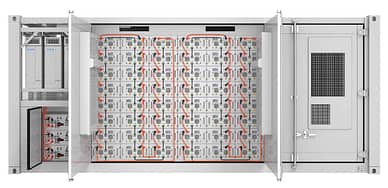Energy storage systems (ESS) are quickly becoming essential to modern energy systems. They are crucial for integrating renewable energy, keeping the grid stable, and enabling charging infrastructure for electric vehicles. To ensure ESS’s safe and reliable operation, rigorous safety standards are needed to guide these systems’ design, construction, testing, and operation. UL9540 is a comprehensive safety standard developed by UL (Underwriters Laboratories) for ESSs with strict safety, performance, and reliability requirements.
What is UL9540?
UL9540 is a safety standard for energy storage systems that UL developed. The standard provides a roadmap for ensuring that ESS works safely and reliably. It covers how these systems are designed, built, tested, and used. UL9540 has strict requirements for electrical safety, thermal safety, mechanical safety, fire safety, system performance, system reliability, and system documentation. Most people agree that the standard is a benchmark for the safety and performance of ESS. The American National Standards Institute (ANSI) and the Standards Council of Canada (SCC) have approved UL9540.
UL9540 doesn’t cover the components of an energy storage system on its own. Instead, it looks at the system as a whole after all the components have been integrated into it. UL9540 covers both stationary installations, indoor and outdoor, and mobile energy storage systems for commercial and residential applications. UL9540 covers different energy storage systems, including electrochemical ESS, chemical ESS, mechanical ESS, and thermal ESS. This could include battery energy storage, flywheel and even fuel cells.
What an Energy Storage System Needs to get UL9540
For an energy storage system (ESS) to be listed by UL9540, it must meet the requirements in the standard. This includes requirements for electrical safety, thermal safety, mechanical safety, fire safety, system performance, system reliability, and system documentation. To meet these requirements, an ESS must undergo rigorous testing and certification, including factory inspection, testing, and follow-up inspections, to ensure they meet the criteria in UL9540.
When UL has received samples from the manufacturer, done a series of tests, and found that the product meets the necessary safety requirements, the ESS is said to be UL9540 listed.
UL9540 vs. UL9540A
UL9540, as previously mentioned, is a set of standards that an energy storage system (ESS) must meet. UL9540a is a method of evaluating thermal runaway in an ESS; it provides additional requirements for battery management systems (BMS) used in ESS. It covers the BMS functions and performance, including battery safety, performance, and communication protocols. Ultimately UL9540a verifies the effectiveness of the ESS protection levels against critical thermal runaway and fire hazards. Testing for UL9540a is done in four steps.
- Cell level testing – The flammability of cells, the likelihood of thermal runaway, and the composition of gasses released are all tested.
- Unit level testing – The potential for fire to spread from unit to unit and the heat release rate and gas composition to assess the risk of an explosion are analyzed.
- Module level testing – The capacity for a thermal runaway to spread from one cell to others within a module and outside of it is evaluated.
- Installation level testing – In the last step, fire suppression equipment is set up in a simulated closed room to see if a fire could spread from one unit to another.

Why UL9540 is so Important for Energy Storage Systems
UL9540 is important for energy storage systems (ESS) because it provides a comprehensive roadmap for ensuring their safe and reliable operation. The standard sets rigorous requirements for the design, construction, testing, and operation of ESS, including batteries, to ensure their safe and reliable operation. By following the requirements of UL9540, ESS can be designed and operated to minimize the risk of electrical shock, thermal runaway, mechanical failure, fire, and other safety hazards. This helps ensure that ESS are safe for both operators and the public and can be relied upon to perform their intended function. Many of EVESCO’s all-in-one energy storage systems are listed by UL9540 to ensure they are as safe and reliable as possible.
Applications that Utilize UL9540 Energy Storage Systems
Applications for energy storage systems vary depending on the need of the energy. Regardless of the applications, UL9540 can evaluate an ESS for safety. Below are some common examples of applications where a UL9540-listed energy storage system could be beneficial.
• Frequency support and regulation
• Capacity reserve
• Energy Shifting
• Electric vehicle supply equipment
• Voltage support and regulation
• Telecom
• UPS
• Other utility-grid support services
Why You Should Choose an C&I Energy Storage System with UL9540
If you choose an energy storage system (ESS) that meets UL9540, it has several advantages over an ESS that doesn’t. First, UL9540-listed ESSs are built and tested to meet strict safety requirements. This reduces the risk of electrical shock, thermal runaway, mechanical failure, fire, and other safety risks. Second, UL9540-listed ESSs are built and tested to ensure they meet strict performance and reliability requirements. This means you can count on them to do what they were made to do. Lastly, UL9540 is used by industry, regulators, and consumers to ensure that the ESS works safely and reliably. It is widely known as a benchmark for ESS safety and performance.
Categories: Blog,
Evesco
Evesco

UL 9540 Listed Energy Storage System
A 1 MW / 2 MWh containerized all-in-one battery energy storage system from EVESCO, the ES-10002000S is UL 9540 listed.